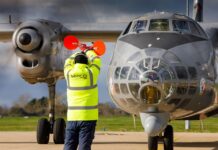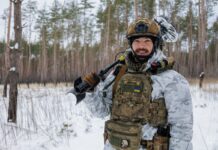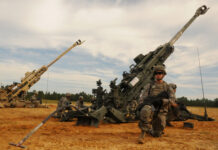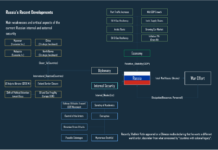Thermobaric weapons, also known as Fuel Air Explosives (FAE), vacuum or aerosol bombs,
dual-stage explosives or enhanced-blast weapons, have been developed and deployed by various militaries for a range of applications since WW2. Their latest high-profile appearance has, of course, been their documented use by Russia in its war on Ukraine.
From FAE mine-clearing systems deployed by armoured vehicles, to air dropped bombs, artillery rockets, shoulder-launched grenade systems and more, thermobaric weapons have taken on many forms since the first attempts at FAE weapons appeared in WW2, used by the Germans. Their onward development gathered pace with the US Air Force following its development of conventional systems that incorporated a thermobaric-type fuel component, for use in clearing swathes of jungle to enable helicopter landings in Vietnam in the 1960s. These applications were only made possible by the enhanced blast effects from the additional fuel and since then, many different thermobaric munitions have been developed and deployed by several militaries, primarily China, Russia, the UK and the US, though with some other national developments.
This article takes a brief look at certain thermobaric weapons, their effects, evolution from conventional munitions and some recent systems and developments, as well as a snapshot on their latest battlefield deployment by Russia in its unjust war on Ukraine.
Thermobaric Mechanism Overview
Thermobaric weapons are volumetric systems, relying on the creation, pervasive dispersal and detonation of a large volume of fuel of varying types, to deliver enhanced terminal effects, making this class of weapon particularly effective against enclosed targets such as bunkers, caves and tunnel systems. Various explosive compositions count as fuel in these weapons, which have either been used and/or are being developed for thermobaric applications; they include liquids, gelled and solid compositions, as well as reactive metals such as aluminium, nano-particles and, more recently, metastable intermolecular composites (MICs).
While typical conventional explosive munitions comprise a fuel-oxidizer pre-mix that is largely oxidizer, such as TNT or RDX, a thermobaric system comprises almost all fuel, making it significantly more energetic than a conventional condensed explosive of similar size. Their reliance on atmospheric oxygen to deliver their blast effects, however, does make them unsuited for use at high altitude, in certain poor weather conditions, and underwater.
Whether a larger thermobaric system launched as a rocket or dropped as a free-falling bomb from an aircraft, or a shoulder-launched blast grenade, thermobaric munitions will typically comprise a fuel container with two separate explosive charges. When a thermobaric munition hits a target, its first charge, or ‘scatter’ charge, explodes to open the fuel container, widely dispersing the contents as a cloud of droplets or aerosol, which covers the target area and, unless a structure is extremely well sealed, penetrates crevices, cracks, windows, doors, tunnels, trenches and buildings. Milli-seconds later a second ‘combustion’ ignites the fuel cloud and atmospheric oxygen to produce a huge blast and fireball, which not only destroy structures and equipment, but also incinerates organic matter caught in the direct blast, or, at the very least, causes devastating injuries to anyone in the area of the explosion. One of the reasons for their terrible effects on humans and animals is the vacuum effect a thermobaric fireball has, creating a negative pressure that ‘sucks all’ the available oxygen from anywhere within its radius, including the oxygen inside the lungs of any souls caught in the blast. The weapon uses the oxygen to generate an intense, high-temperature explosion, which has a sustained blast wave longer in duration than conventional, condensed explosive munitions.
These weapons inflict much of their damage by maximising shockwaves and overpressures, creating waves of energy that cause casualties and damage by crushing, bending, tumbling, and breaking, compounding any effects caused by the fireball. These extraordinary pressures negate many forms of cover and protection used by troops, including underground facilities, trenches and more, and the weapons, in general, have the potential to cause causalities that overwhelm military medical facilities and casevac logistics.
Modern Origins
Since the 1960s, China, Russia, the UK the US and others have developed various thermobaric weapons delivered by platforms such as MLRS, aircraft, as well as shoulder-launched grenades for use by infantry. Modern FAE systems were influenced by, or can be traced back to the 1960’s arrival of the US’ BLU-82. Known as the Daisy Cutter, this was actually the largest conventional munition at that time, though did comprise a percentage of aluminium powder alongside its main explosive; the bomb consisted of ammonium nitrate oxidizer and aluminium powder to enhance blast effects, which is why it is sometimes confused with a thermobaric weapon; it had a 970 mm-long fuze extender, which effected detonation above the ground to ensure optimum destruction at ground level, but without forming a crater that would have impeded helicopter landings. It delivered an overpressure of 1,000 pounds per square inch near ground zero. The BLU-82 was used in Vietnam initially to blast clearings in the jungle for helicopters, as well as for artillery emplacements, but it was also later used for clearing minefields, against troops in defensive positions and in the open, and against logistics supply lines, warehouses and vehicle parks. First dropped on 22 March 1970 by a C-130 in Vietnam, the BLU-82 was finally retired in 2008. Its replacement, the more powerful Mother of All Bombs (MOAB), GBU-43/B, had already been developed and first tested in 2003. Its explosive mixture initially trialled was tritonal, 80 per cent TNT and 20 per cent aluminium powder and said to be some 18 per cent more powerful than just TNT on its own, though this was still not a thermobaric weapon per se, but the evolution towards such systems was clear.
Thermobarics
The US produced some of its first thermobarics for use in Vietnam, including the CBU-55 cluster bomb, developed by the US Naval Weapons Center. Though seldom used, the 340 kg air-dropped CBU-55 was fuelled mainly by propane. It is understood the US currently has at least seven thermobaric munitions in its inventory, including the SMAW-NE (see below), the BLU-73, BLU-95 230 kg FAE-II and the BLU-96 910 kg FAE-II bombs. Its AGM-114N Hellfire II missile is also a thermobaric munition as is the XM1060 40-mm grenade, which is a small-arms-delivered device, in use by US forces since 2003. The Hellfire warhead contains a thermobaric explosive fill of aluminium powder mixed with polytetrafluoroethylene layered between the charge casing and a PBXN-112 explosive. Rapid burn of the aluminium and sustained high pressure blast makes the weapon effective against personnel and structural emplacements.
The Russians have some of the most recent extensive pedigree in the use of thermobaric weapons. In the Soviet war in Afghanistan, for example, a TOS-1 MLRS thermobaric system was introduced and used during operations in the Panshir Valley, and ODAB-500S/P FAE bombs were dropped by MiG-27s at various times during the conflict. Later, during the 1990s, the TOS-1 BURATINO, as it was known, played major parts in both Chechen Wars, including in the destruction of Grozny and elsewhere against fortified, entrenched, Chechen positions. The purpose-built TOS-1 has 24 rocket tubes, (some latest versions have 30), mounted on a T-72 chassis and fires 220 mm thermobaric rockets with a full salvo capable of covering a 200 m x 400 m area. Chechnya also saw the use of the shoulder-launched RPO-A SHMEL personal thermobaric grenade.
When it comes to Afghanistan, however, Russia is not the only occupying force to have used thermobarics; during the first and second battles for Fallujah in 2004 the USMC used the Shoulder-Launched Multi-Purpose Assault Weapon – Novel Explosive (SMAW-NE) enhanced-blast weapon and, in separate operations, the USAF dropped a single 2,000 lb laser-guided thermobaric bomb on cave complexes in the Gardez region used by Al-Qaeda and Taliban fighters. Of the SMAW-NE’s use in Falluja, an article in the USMC Marine Corps Gazette magazine in 2005, said: “Marines could employ blast weapons prior to entering houses that had become pillboxes, not homes. The economic cost of house replacement is not comparable to American lives… all battalions adopted blast techniques appropriate to entering a bunker, assuming you did not know if the bunker was manned. … SMAW gunners became expert at determining which wall to shoot to cause the roof to collapse and crush the insurgents fortified inside interior rooms. … Due to the lack of penetrating power of the NE round, we found that our ‘assaultmen’ had to first fire a dual-purpose rocket in order to create a hole in the wall or building. This blast was immediately followed by an NE round that would incinerate the target or literally level the structure.”
Russia’s big-bomb thermobaric leap came in 2007, when it unveiled its Father of All Bombs (FOAB), a true thermobaric munition, (unlike the BLU-82), claimed to be four times more powerful than the MOAB. Russian claims have also been made that the FOAB’s effects are deadlier than those of the US MOAB due to temperatures at the centre of the blast being twice as high as MOAB; FOAB’s blast radius is said to be 300 metres, twice that of the BLU-82. Officially termed an aviation thermobaric bomb of increased power (ATBIP), the bomber-delivered, GLONASS-guided FOAB munition is said to have replaced certain tactical nuclear weapons in Russia’s arsenal and, indeed, is reputed to deliver a yield equivalent to 44 tons of TNT using seven tons of a newly developed explosive composition. Detonating above ground, its blast and pressure wave have similar effects to a tactical nuclear weapon and unconfirmed reports by the Russian Ministry of Defence state that the weapon was used in September 2017 in Russia’s Syrian campaign alongside Syrian government forces.
Today, Russian forces are equipped with a number of latest-generation thermobaric munitions, from the shoulder-launched RPO-A SHMEL rocket and launcher to a number of thermobaric ammunition variants for use by several standard weapons and platforms. The TBG-7V grenade, for example, can be launched by a standard RPG-7 and has a lethality radius of 10 m. It is one of several smaller FAE systems for use in close-quarter scenarios. In addition, upgraded man-portable RPG systems now also have thermobaric rocket munitions that, in some cases, deliver a blast equivalent to almost 6 kg of TNT with a destructive power similar to a 155 mm HE artillery round. Several Russian infantry anti-tank systems, including the 9M133 KORNET, have thermobaric warhead variants that can be used instead of a standard anti-tank missile; the KORNET’s variant, for example, has a maximum range of 10 km and a TNT equivalence of 7 kg. ISKANDER-M theatre ballistic missiles, as well as a wide range of Russian Air Force guided and unguided bombs and ATGMs have thermobaric variants, some potentially in use in Ukraine. Beyond Russia and the US, China, the UK, India and Spain have all developed and hold FAE/thermobaric systems in their arsenals, though space precludes looking at these in this article.
Thermobaric Use in Ukraine
The UK MoD, other western sources, as well as the Russians themselves, have now confirmed that Russia has deployed and used thermobaric weapons in Ukraine. It’s impossible to know at this stage how many thermobaric strikes there have been and on what targets, but early in the war, the Russian TOS-1A was said to have been used on the battlefield, with at least one vehicle filmed by western media in the process of setting up its position, before journalists were warned off by its crew. In April, reports said Ukrainian forces had used a captured TOS-1A ‘Flamethrower’ – these systems have several nicknames — against Russian forces near Izyum, having supposedly captured several of the systems during the conflict, though at time of writing only the one has been used by the Ukrainians on this one documented occasion.
In late May, Russia’s Tass news agency quoted a Russian security official, saying it had fired its latest TOS-2 TOSOCHKA thermobaric system against Ukrainian targets in the Kharkiv area. (The TOS-2 also known as the TOSOCHKA BM-2, or ARMATA TOS-2, is the intended replacement for the TOS-1 Buratino). Late May drone footage did indeed show thermobaric rounds exploding on alleged Ukrainian defensive positions in the east of the country, though these were quoted at the time as being from Russia’s TOS-1A SOLNTSEPEK Flamethrower system. [Seeing footage of the immense blast and fireball, far beyond that made by any standard 155 mm HE artillery round, it is hard to imagine how anyone under such a barrage could survive, knowing the effects they deliver. Ed]
The Ukrainians will not, however, be surprised by the latest use of thermobarics against them, having experienced a devastating artillery bombardment against four armoured battalions near the town of Zelonopillya in July of 2014. Thermobaric missiles and bombs were amongst a mix of munitions included in the barrage that destroyed these battalions in that one terrible event.
A sobering, final note: a former commander of the US Army Field Artillery School at Fort Sill is reported to have said that the lethal area produced by Russian Artillery thermobaric rockets is up to 10 times greater than that produced by a US Army MLRS battalion delivering equivalent, conventional fires.
Tim Guest












